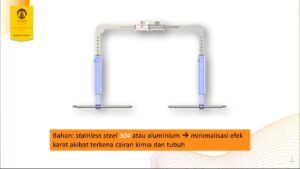Universitas Indonesia (UI), through the Faculty of Medicine, has created two new innovations, namely the C-Clamp Modified Pelvic Fixation Device and the Periarticular External Fixation Device. The creation of these two medical devices was motivated by trauma, which is the third highest cause of death in all age groups in the world. Pelvic fracture is a disease that can occur due to trauma and is the orthopedic injury that most often claims lives with a mortality rate as high as 6–35%.
To prevent death in patients with fractures of the pelvic bones and long bones in the legs, orthopedic doctors need to correct the patient’s bone deformities using fixation aids. Unfortunately, the device with a modification of the C-Clamp model invented by Ganz which has been commonly used has limitations, including impractical installation, the size cannot be adjusted so it is difficult to use in patients with large abdominal circumferences, and has a very expensive price.

Seeing this condition, Professor of Orthopedics and Traumatology, FKUI–Hospital, Dr. Cipto Mangunkusumo (RSCM), Prof. Dr. dr. Ismail Hadisoebroto Dilogo, Sp.OT(K) and his team collaborated with PT Eka Ormed Indonesia to produce C-Clamp Modified Pelvic Fixation Devices and Periarticular External Fixation Devices.
The C-Clamp Modified Pelvic Fixation Device was created for fixation of posterior pelvic fractures which often result in death due to excessive blood loss. The way this tool works is by fixing two right and left nails in the pelvic bone area. This product has the advantage of fast and manual installation or without the need for special tools. Apart from that, this tool is flexible because the height and width can be adjusted according to the patient’s body shape or size, and has an affordable price.
This problem solving idea uses several concepts in structural mechanics and develops product concepts from references and existing products. Development is tailored to the manufacturing capabilities. This means that the materials and tools come from within the country and the manufacturing process is carried out within the country. The materials for this tool use stainless steel 304 and aluminum to minimize the effects of rust due to chemical and body fluids. The components consist of rod, nut, holder clamp and schanz screw.
The C-Clamp Modified Pelvic Fixation Device has been used in several areas, namely Jakarta, Pekalongan, Semarang, Surabaya, Malang, and Klaten, and has been proven to be effective. Since obtaining a patent from the Indonesian Ministry of Law and Human Rights in 2011, this tool has continued to be developed and adapted to patient needs.
Meanwhile, the Periarticular External Fixation Device is a fixation aid used for complex fractures in long bones near joints and reconstruction of long bones with abnormalities. One of the health problems in Indonesia is the high number of neglected fracture cases (bone fractures that are not treated or receive inappropriate treatment) which can lead to disability. This is related to the low level of knowledge and treatment at traditional healers for fractures.
This fixation device can be used in cases of indicated knee infections. This Periarticular External Fixation Invention can also overcome the weaknesses of several previously existing periarticular external fixation devices. This device is able to fixate fractures near the joint (a limitation of previous devices) and can provide better stability in very complex fractures.
Apart from that, this tool is good for treating cases of complex open fractures, neglected fractures that need reconstruction, as well as bones that have experienced shortening or severe shifting. In cases of infected knees, this tool can be used as an arthrodesis tool (joint fusion) so that the patient’s knee does not hurt and the infection disappears.
The Periarticular External Fixation Device consists of a shaft which will function as a chassis and 2 types of nail holders which will be implanted in the bone. Type 1 nail holders in a row can be used when the surface area of the bone is wide enough to plant nails in a more stable condition. Type 2 nail holders can be used on small bone surface areas.
This tool is made of 304 stainless steel (shaft and nail holder) and aluminum (for the larger shaft and holder). This material was chosen because it is able to minimize the effects of rust due to exposure to chemical fluids and the body. The Periarticular External Fixation Device has received a patent certificate since 2013 and has been distributed to patients in several cities, including Jakarta, Medan, Sampang, Pekalongan, Klaten and Solo.
These two tools are actually a form of the third pillar of health transformation, namely the transformation of the health resilience system. It is hoped that this innovation can encourage UI to continue producing new works, not only in the health sector, but also in the social-humanities and science-technology fields.



